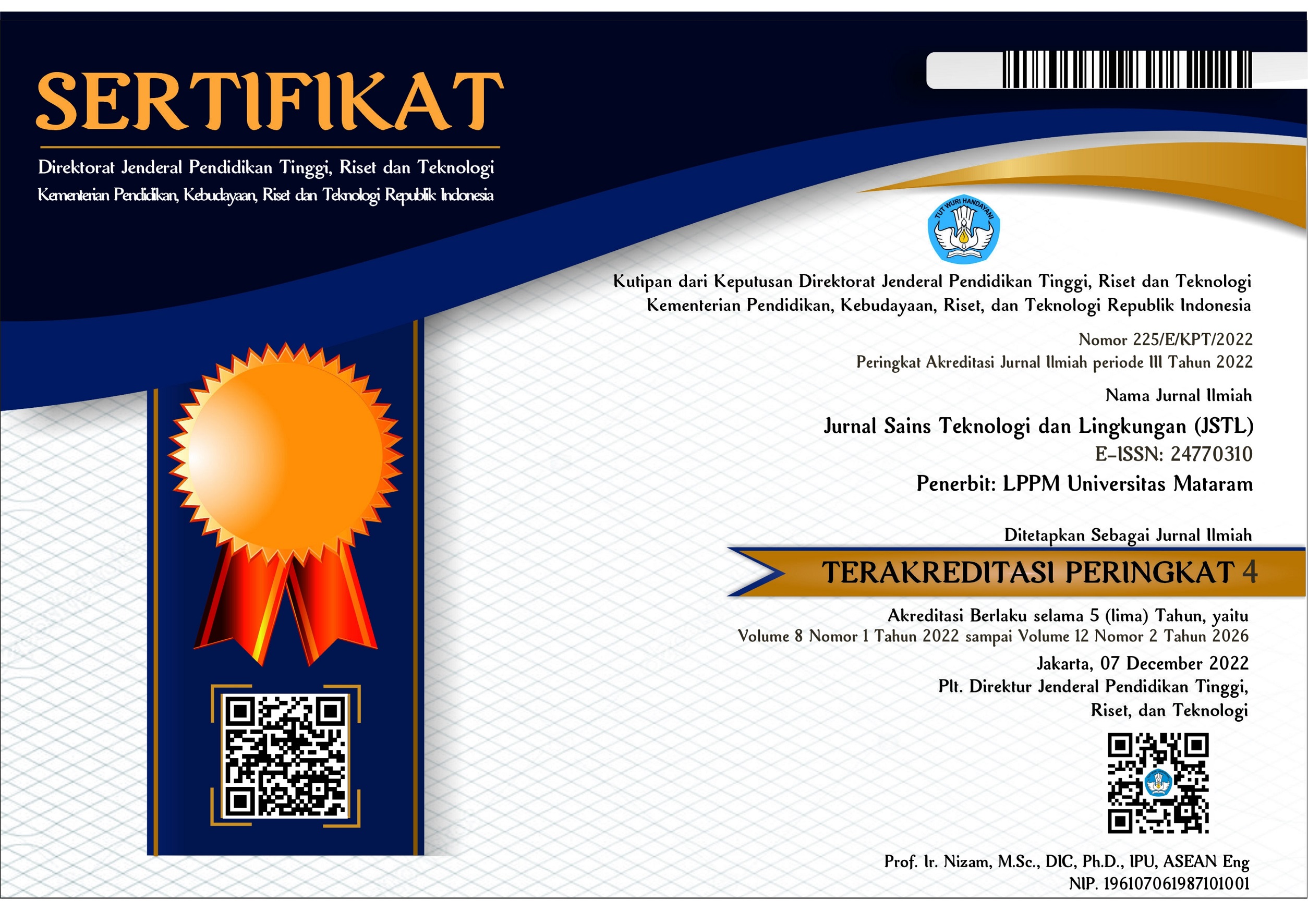Keanekaragaman Lumut sebagai Bioindikator Kualitas Udara di Kawasan Taman Wisata Alam Suranadi dan Ruang Terbuka Hijau Udayana
Moss Plant Diversity as a Bioindicator of air Quality in Suranadi Natural Park and Green Open Space of Udayana
DOI:
https://doi.org/10.29303/jstl.v9i2.467Keywords:
mosses, diversity index, air quality, bioindicatorAbstract
Different intensity of transportation in Suranadi Natural Park and Green Open Space of Udayana effected in air quality. Decreasing of the air quality will have a serious impact on the enviroment, human health and the economy. Moss can accumulate pollutants and is sensitive to air quality degradation. it can be used as a bioindicator. The aim of the research was to determine the diversity index, abundance index of mosses and analyze air quality in the TWA Suranadi and RTH of Udayana. The research method uses quadrant 10 x 10 m whic is placed by purposive sampling. The diversity index (H′) in TWA Suranadi is low category (H′=1.4) with 5 species founded. Species with a high abundance index were Andreae sp. (45.45%), Brachythecium rutabulum (18.18%) and Taxiphyllum sp. (18.18%), while Lejeunea laetevirens (9.09%) and Hypnum cupressiforme (9.09%) are low category. The index diversity in Udayana RTH is low category (H′=1.2) with 4 species founded. Species with a high abundance index were Octoblepharum albidum (44.44%), Dicranoweisia crispula (22.22%) and Lopholejeunea sp (22.22%), while Barbula sp (11.11%) was moderate category. The moss diversity index in TWA Suranadi is higher than in Udayana RTH. Air quality in both areas is still below the threshold. Air quality affects the diversity index. Periodic monitoring of air quality needs to determine the effectiveness of mosses in absorbing pollutants.References
Apriana, D. 2010. Keragaman dan Kelimpahan Lumut Epifit di Kebun Raya Bogor. Skripsi. Program Studi Biologi Fakultas Matematika dan Ilmu Pengetahuan Alam Institut Pertanian Bogor, Bogor.
Brower, J.E., J.H. Zar & C.N. von Ende. 1990. Field and Laboratory Methods for General Ecology 3 rd ed. Wm.C Brown Publisher: Dubouque.
Bawaihaty, N. et al. 2014. Keragaman dan Peran Ekologi Bryophyta di Hutan Sesaot Lombok Barat. Jurnal Silvikultur Tropika. 5(1): 13-17.
Fanani., Mirza., Afriyansyah, B. 2019. Keanekaragaman Jenis Lumut (Bryophyta) Pada Berbagai Substrat di Bukit Muntai Kabupaten Bangka Selatan. Jurnal Penelitian Biologi, Botani, Zoologi dan Mikrobiologi. 4(2): 43–47.
Firdaus, F. 2020. Keanekaragaman dan Pola Distribusi Tumbuhan Lumut (Bryophyta) di Jalur Pendakian Gunung penanggungan Jawa Timut. Thesis, Universitas Islam Negeri Maulana Malik Ibrahim.
Fitria, R., Kamal, S., dan Eriawati. 2018. Keanekaragaman Lumut (Bryophytes) pada berbagai Substrat di Kawasan Sungai Pucok Krueng Raba Kecamatan Lhoknga Kabupaten Aceh Besar. Prosiding Senimar Nasional Biotik. Aceh.
Husamah dan Rahardjanto, A. 2019. Bioindikator (Teori dan Aplikasi dalam Biomonitoring). Malang, Universitas Muhammadiyah Malang Press.
Indriyanto. 2006. Ekologi Hutan. Bumi Aksara, Jakarta.
Ivhone, N. N., Irwandi, dan Hartati, M. S. 2018. Jenis-Jenis Tumbuhan Lumut (Bryophyta) pada Berbagai Subtrat di Desa Pasar Melintang Kota Bengkulu. Prosiding Senimar Nasional Biotik. Aceh: 172-182.
Kusumawati, P. S., Tang, U. M., and Nurhidayah, T. 2013. Hubungan Jumlah Kendaraan Bermotor, Odometer Kendaraan Dan Tahun Pembuatan Kendaraan Dengan Emisi Co2 di Kota Pekanbaru. Jurnal Ilmu Lingkungan.7(1): 49-59.
LeBlanc, F. & D.N. Rao. 1973. Evaluation of The Pollution and Drought Hypotheses in Relation to Lichens and Bryophytes in Urban Environments. The Bryologist. 76(1): 1- 16.
Ludwig, J. A. and J. F. Reynold. 1988. Statistical Ecology. John Willey and Sons, New york.
Lukitasari, M. 2018. Mengenal Tumbuhan Lumut (Bryophyta) Deskripsi, Klasifikasi, Potensi dan Cara Mempelajarinya. Magetan, Media Grafika.
Macedo-Miranda, G., Avila-Pérez, P., Gil-Vargas, P. 2016. Accumulation of heavy metals in mosses: a biomonitoring study. Springerplus. 5 (715): 1-13.
Mahaprata, B., Dhal, N. K., Dash, A. K., Panda, B. P., Panigrahi, K. C. S.m and Pradhan, A. 2018. Perspective of Mitigating Atmospheric Heavy Metal Pollution: Using Mosses as niomonitorung and indicator organism. Enviromental Science and Pollution Research. 26: 29620-29638.
Masyitoh, A. D., Saputri, I., Antika, I. R., Ifannani, F. A., Simanjuntak, A. L., Safitri, N. R., dan Fardhani, I. 2023. Moss Plant Biodiversity (Bryophyta) Around Rojo Camp Gardens, Dau District, Malang Regency. Journal of Reseach in Science Education. 9(6): 4423-4430.
Nuriati, F. 2022. Analisis Keragaman Lumut (Bryophyta) di Kawasan Taman Nasional Way Kambas Lampung Timur. Skripsi. Program Studi Pendidikan Biologi, Universitas Islam Negeri Raden Intan. Lampung.
Odum, E. P. 1996. Dasar – Dasar Ekologi: edisi ketiga. Gadjah Mada University Press, Jogjakarta.
Peck, J., dan Won, S. 1995. Diversity of Epiphytic Bryophytes in Three Host Tree Species, Thermal Meadow, Hotspring Island, Queen Charlotte Island, Canada. The Bryologist. 98(1): 123 - 128.
Putri, Erika, S., dan Prayogo, H. 2019. Inventarisasi Jenis-Jenis Lumut Di Kawasan Hutan Adat Bukit Benuah Kabupaten Kubu Raya. Jurnal Hutan Lestari. 7(3): 47-53.
Raihan, C., Nurasiah, dan Zahara, N. 2018. Keanekaragaman Tumbuhan Lumut (Bryophyta) di Air Tejun Peucari Bueng Jantho Kabupaten Aceh Besar. Prosiding Senimar Nasional Biotik. Aceh. ISBN: 978-603-6040-9-0.
Rusidi, Hendi, and Santi, R. 2021. Keanekaragaman Jenis Lumut (Bryophyta) di Bukit Nenek Taman Wisata Gunung Permisan, Kabupaten bangka Selatan. Jurnal Biologi Udayana. 25(2): 137-146.
Sofi, A., Cahyana, D., dan Maolidah, E. Lumut (Bryophyta). Makalah. Program Studi Biologi, Universitas Islam Negeri Sunan Gunung Djati, Bandung.
Sudjatmiko, H., dan Amalia, N.N. 2022. Keanekaragaman Bryophytes di Candi Plaosan, Jawa Tengah. Berkala Ilmiah Niologi. 13(3): 25-34.
Windadri, F. I. 2009. Keragaman Lumut Di Resort Karang Ranjang, Taman Nasional Ujung Kulon, Banten. Jurnal Teknik Lingkungan.10(1): 19- 25.
Wirda, A. Z. U. (2019). Inventory of Plant Moss Species (bryophyta) Terrestrial in National Park Area Aketajawe Lolobata Central Halmahera North Maluku Province. Journal of Physics: Conference Series. 1364(1): 1-20.
Downloads
Published
Issue
Section
License

This work is licensed under a Creative Commons Attribution-NonCommercial-ShareAlike 4.0 International License.


1.png)











